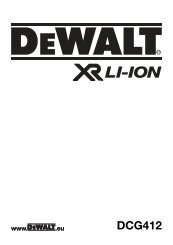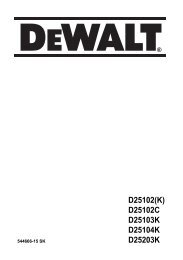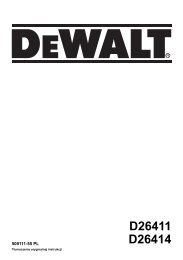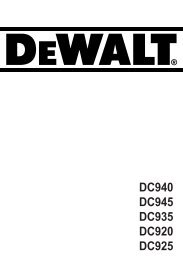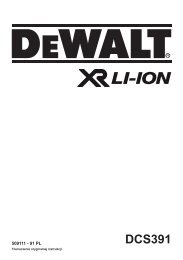Notice d'utilisation - Service après vente - Dewalt
Notice d'utilisation - Service après vente - Dewalt
Notice d'utilisation - Service après vente - Dewalt
You also want an ePaper? Increase the reach of your titles
YUMPU automatically turns print PDFs into web optimized ePapers that Google loves.
www. .eu<br />
DWD112<br />
DWD112S
2<br />
English (original instructions) 3<br />
Français (traduction de la notice d’instructions originale) 9<br />
Copyright DEWALT
Figure 1<br />
d<br />
DWD112<br />
d<br />
DWD112S<br />
Figure 2<br />
c<br />
a<br />
c<br />
a<br />
c<br />
b<br />
a<br />
b<br />
b<br />
e<br />
e<br />
Figure 3<br />
f<br />
1
Figure 4<br />
Figure 5 Figure 6<br />
2<br />
Figure 7 Figure 8<br />
d
VARIABLE SPEED REVERSIBLE DRILL<br />
DWD112, DWD112S<br />
Congratulations!<br />
You have chosen a DEWALT tool. Years of<br />
experience, thorough product development and<br />
innovation make DEWALT one of the most reliable<br />
partners for professional power tool users.<br />
Technical Data<br />
DWD112 DWD112S<br />
Voltage V AC 220/240 220/240<br />
120 120<br />
Type 1/2 1/2<br />
Power input W 701 701<br />
No load speed min -1 0-2,500 0-2,500<br />
Maximum drilling range<br />
steel/wood/concrete mm 10/25/13 10/25/13<br />
Torque Nm 10.9 10.9<br />
Chuck spindle thread size UNF 1/2"x20 1/2"x20<br />
Maximum chuck capacity mm 10 10<br />
Weight kg 1.9 1.83<br />
Defi nitions: Safety Guidelines<br />
The definitions below describe the level of severity<br />
for each signal word. Please read the manual and<br />
pay attention to these symbols.<br />
DANGER: Indicates an imminently<br />
hazardous situation which, if not avoided,<br />
will result in death or serious injury.<br />
WARNING: Indicates a potentially<br />
hazardous situation which, if not<br />
avoided, could result in death or<br />
serious injury.<br />
CAUTION: Indicates a potentially<br />
hazardous situation which, if not<br />
avoided, may result in minor or<br />
moderate injury.<br />
NOTICE: Indicates a practice not<br />
related to personal injury which, if<br />
not avoided, may result in property<br />
damage.<br />
Denotes risk of electric shock.<br />
Denotes risk of fire.<br />
ENGLISH<br />
WARNING: To reduce the risk of injury,<br />
read the instruction manual.<br />
General Power Tool Safety Warnings<br />
WARNING! Read all safety warnings<br />
and all instructions. Failure to follow<br />
the warnings and instructions may result<br />
in electric shock, fire and/or serious<br />
injury.<br />
SAVE ALL WARNINGS AND INSTRUCTIONS<br />
FOR FUTURE REFERENCE<br />
The term “power tool” in the warnings refers to your<br />
mains-operated (corded) power tool or batteryoperated<br />
(cordless) power tool.<br />
1) WORK AREA SAFETY<br />
a) Keep work area clean and well lit.<br />
Cluttered or dark areas invite accidents.<br />
b) Do not operate power tools in explosive<br />
atmospheres, such as in the presence of<br />
flammable liquids, gases or dust. Power<br />
tools create sparks which may ignite the dust<br />
or fumes.<br />
c) Keep children and bystanders away while<br />
operating a power tool. Distractions can<br />
cause you to lose control.<br />
2) ELECTRICAL SAFETY<br />
a) Power tool plugs must match the outlet.<br />
Never modify the plug in any way. Do<br />
not use any adapter plugs with earthed<br />
(grounded) power tools. Unmodified plugs<br />
and matching outlets will reduce risk of<br />
electric shock.<br />
b) Avoid body contact with earthed or<br />
grounded surfaces such as pipes,<br />
radiators, ranges and refrigerators. There<br />
is an increased risk of electric shock if your<br />
body is earthed or grounded.<br />
c) Do not expose power tools to rain or wet<br />
conditions. Water entering a power tool will<br />
increase the risk of electric shock.<br />
d) Do not abuse the cord. Never use the<br />
cord for carrying, pulling or unplugging<br />
the power tool. Keep cord away from<br />
heat, oil, sharp edges or moving parts.<br />
Damaged or entangled cords increase the<br />
risk of electric shock.<br />
e) When operating a power tool outdoors,<br />
use an extension cord suitable for outdoor<br />
use. Use of a cord suitable for outdoor use<br />
reduces the risk of electric shock.<br />
3
ENGLISH<br />
f) If operating a power tool in a damp<br />
location is unavoidable, use a residual<br />
current device (RCD) protected supply.<br />
Use of an RCD reduces the risk of electric<br />
shock.<br />
3) PERSONAL SAFETY<br />
a) Stay alert, watch what you are doing and<br />
use common sense when operating a<br />
power tool. Do not use a power tool while<br />
you are tired or under the influence of<br />
drugs, alcohol or medication. A moment of<br />
inattention while operating power tools may<br />
result in serious personal injury.<br />
b) Use personal protective equipment.<br />
Always wear eye protection. Protective<br />
equipment such as dust mask, non-skid<br />
safety shoes, hard hat, or hearing protection<br />
used for appropriate conditions will reduce<br />
personal injuries.<br />
c) Prevent unintentional starting. Ensure<br />
the switch is in the off position before<br />
connecting to power source and/or<br />
battery pack, picking up or carrying the<br />
tool. Carrying power tools with your finger<br />
on the switch or energising power tools that<br />
have the switch on invites accidents.<br />
d) Remove any adjusting key or wrench<br />
before turning the power tool on. A<br />
wrench or a key left attached to a rotating<br />
part of the power tool may result in personal<br />
injury.<br />
e) Do not overreach. Keep proper<br />
footing and balance at all times. This<br />
enables better control of the power tool in<br />
unexpected situations.<br />
f) Dress properly. Do not wear loose<br />
clothing or jewellery. Keep your hair,<br />
clothing and gloves away from moving<br />
parts. Loose clothes, jewellery or long hair<br />
can be caught in moving parts.<br />
g) If devices are provided for the connection<br />
of dust extraction and collection facilities,<br />
ensure these are connected and properly<br />
used. Use of dust collection can reduce<br />
dust-related hazards.<br />
4) POWER TOOL USE AND CARE<br />
a) Do not force the power tool. Use the<br />
correct power tool for your application.<br />
The correct power tool will do the job<br />
better and safer at the rate for which it<br />
was designed.<br />
b) Do not use the power tool if the switch<br />
does not turn it on and off. Any power<br />
tool that cannot be controlled with the switch<br />
is dangerous and must be repaired.<br />
4<br />
c) Disconnect the plug from the power<br />
source and/or the battery pack from<br />
the power tool before making any<br />
adjustments, changing accessories, or<br />
storing power tools. Such preventive safety<br />
measures reduce the risk of starting the<br />
power tool accidentally.<br />
d) Store idle power tools out of the reach<br />
of children and do not allow persons<br />
unfamiliar with the power tool or these<br />
instructions to operate the power tool.<br />
Power tools are dangerous in the hands of<br />
untrained users.<br />
e) Maintain power tools. Check for<br />
misalignment or binding of moving parts,<br />
breakage of parts and any other condition<br />
that may affect the power tool’s operation.<br />
If damaged, have the power tool repaired<br />
before use. Many accidents are caused by<br />
poorly maintained power tools.<br />
f) Keep cutting tools sharp and clean.<br />
Properly maintained cutting tools with sharp<br />
cutting edges are less likely to bind and are<br />
easier to control.<br />
g) Use the power tool, accessories and<br />
tool bits etc., in accordance with these<br />
instructions taking into account the<br />
working conditions and the work to<br />
be performed. Use of the power tool for<br />
operations different from those intended<br />
could result in a hazardous situation.<br />
5) SERVICE<br />
a) Have your power tool serviced by a<br />
qualified repair person using only identical<br />
replacement parts. This will ensure that the<br />
safety of the power tool is maintained.<br />
Additional Specifi c Safety Rules<br />
for Drills<br />
• Wear ear protectors. Exposure to noise can<br />
cause hearing loss.<br />
• Use auxiliary handles supplied with the<br />
tool. Loss of control can cause personal<br />
injury.<br />
• Hold power tool by insulated gripping<br />
surfaces only, when performing an<br />
operation where the cutting accessory<br />
may contact hidden wiring or its own<br />
cord. Cutting accessory contacting a “live”<br />
wire may make exposed metal parts of the<br />
power tool “live” and shock the operator.<br />
• Use clamps or other practical way to<br />
secure and support the workpiece to a<br />
stable platform. Holding the work by hand<br />
or against your body is unstable and may<br />
lead to loss of control.
• Wear safety goggles or other eye<br />
protection. Drilling operations cause chips to<br />
fly. Flying particles can cause permanent eye<br />
damage.<br />
• Bits and tools get hot during operation.<br />
Wear gloves when touching them.<br />
• Keep handles dry, clean, free from oil and<br />
grease. it is recommended to use rubber<br />
gloves. This will enable better control of the<br />
tool.<br />
Residual Risks<br />
In spite of the application of the relevant safety<br />
regulations and the implementation of safety<br />
devices, certain residual risks cannot be avoided.<br />
These are:<br />
– Impairment of hearing.<br />
– Risk of personal injury due to flying particles.<br />
– Risk of burns due to accessories becoming hot<br />
during operation.<br />
– Risk of personal injury due to prolonged use.<br />
Markings on Tool<br />
The following pictograms are shown on the tool:<br />
Read instruction manual before use.<br />
DATE CODE POSITION (FIG. 1)<br />
The date code (f), which also includes the year of<br />
manufacture, is printed into the housing.<br />
Example:<br />
2013 XX XX<br />
Year of Manufacture<br />
Package Contents<br />
The package contains:<br />
1 Drill<br />
1 Chuck key (DWD112)<br />
1 Instruction manual<br />
1 Exploded drawing<br />
• Check for damage to the tool, parts or<br />
accessories which may have occurred during<br />
transport.<br />
• Take the time to thoroughly read and<br />
understand this manual prior to operation.<br />
ENGLISH<br />
Description (fi g. 1)<br />
WARNING: Never modify the power<br />
tool or any part of it. Damage or<br />
personal injury could result.<br />
a. Variable speed trigger switch<br />
b. Lock-on button<br />
c. Forward/reverse button<br />
d. Chuck<br />
e. Main handle<br />
INTENDED USE<br />
These heavy-duty V.S.R. drills are designed for<br />
professional drilling.<br />
DO NOT use under wet conditions or in presence of<br />
flammable liquids or gases.<br />
These heavy-duty drills are professional power tools.<br />
DO NOT let children come into contact with the<br />
tool. Supervision is required when inexperienced<br />
operators use this tool.<br />
• This product is not intended for use by persons<br />
(including children) suffering from diminished<br />
physical, sensory or mental abilities; lack of<br />
experience, knowledge or skills unless they are<br />
supervised by a person responsible for their<br />
safety. Children should never be left alone with<br />
this product.<br />
Electrical Safety<br />
The electric motor has been designed for one<br />
voltage only. Always check that the power supply<br />
corresponds to the voltage on the rating plate.<br />
Your DEWALT tool is double insulated in<br />
accordance with EN 60745; therefore no<br />
earth wire is required.<br />
WARNING: 120 V units have to<br />
be operated via a fail-safe isolating<br />
transformer with an earth screen<br />
between the primary and secondary<br />
winding.<br />
If the supply cord is damaged, it must be replaced<br />
by a specially prepared cord available through the<br />
DEWALT service organisation.<br />
Mains Plug Replacement<br />
(Middle East and Africa)<br />
If a new mains plug needs to be fitted:<br />
• Safely dispose of the old plug.<br />
• Connect the brown lead to the live terminal in<br />
the plug.<br />
5
ENGLISH<br />
6<br />
• Connect the blue lead to the neutral terminal.<br />
WARNING: No connection is to be<br />
made to the earth terminal.<br />
Follow the fitting instructions supplied with good<br />
quality plugs. Recommended fuse: 13 A.<br />
Using an Extension Cable<br />
If an extension cable is required, use an approved<br />
extension cable suitable for the power input of this<br />
tool (see Technical Data). The minimum conductor<br />
size is 1 mm 2 ; the maximum length is 30 m.<br />
When using a cable reel, always unwind the cable<br />
completely.<br />
ASSEMBLY AND ADJUSTMENTS<br />
WARNING: To reduce the risk of<br />
injury, turn unit off and disconnect<br />
machine from power source before<br />
installing and removing accessories,<br />
before adjusting or changing setups<br />
or when making repairs. Be sure<br />
the trigger switch is in the OFF position.<br />
An accidental start-up can cause injury.<br />
OPERATION<br />
Instructions for Use<br />
WARNING: Always observe the safety<br />
instructions and applicable regulations.<br />
WARNING: To reduce the risk<br />
of serious personal injury, turn<br />
tool off and disconnect tool from<br />
power source before making any<br />
adjustments or removing/installing<br />
attachments or accessories.<br />
Proper Hand Position (fi g. 1, 3)<br />
WARNING: To reduce the risk of<br />
serious personal injury, ALWAYS<br />
use proper hand position as shown<br />
in figure 3.<br />
WARNING: To reduce the risk of<br />
serious personal injury, ALWAYS hold<br />
securely in anticipation of a sudden<br />
reaction.<br />
Proper hand position requires one hand under<br />
the the housing, with the other hand on the main<br />
handle (e).<br />
Switches (fi g. 1, 2)<br />
To start the drill, depress the trigger switch; to stop<br />
the drill, release the trigger.<br />
A variable speed trigger switch (a) permits speed<br />
control—the farther the trigger is depressed, the<br />
higher the speed of the drill.<br />
For continuous operation, press and hold the<br />
variable speed switch, move the lock-on button (b)<br />
up, then release the switch.<br />
NOTE: Use lower speeds for starting holes without<br />
a center punch, drilling in metal or plastics, driving<br />
screws or drilling ceramics. Higher speeds are better<br />
for drilling wood and composition boards and using<br />
abrasive and polishing accessories.<br />
The forward/reverse lever (c) is used for withdrawing<br />
bits from tight holes and removing screws. It is<br />
located above the trigger switch. To reverse the<br />
motor, release the trigger switch FIRST and then<br />
push the lever to the right. After any reversing<br />
operations, return lever to forward position.<br />
To stop continuous operation, press the switch<br />
briefly and release it. Always switch the tool off when<br />
work is finished and before unplugging.<br />
Drilling<br />
WARNING: To reduce the risk of<br />
personal injury, ALWAYS ensure<br />
workpiece is anchored or clamped<br />
firmly. If drilling thin material, use a wood<br />
“back-up” block to prevent damage to<br />
the material.<br />
1. Use sharp drill bits only. For WOOD, use twist<br />
drill bits, spade bits, power auger bits, or hole<br />
saws. For METAL, use steel twist drill bits or<br />
hole saws.<br />
2. Always apply pressure in a straight line with the<br />
bit. Use enough pressure to keep drill biting, but<br />
do not push hard enough to stall the motor or<br />
deflect the bit.<br />
3. Hold tool firmly with both hands to control the<br />
twisting action of the drill.<br />
4. IF DRILL STALLS, it is usually because<br />
it is being overloaded or improperly used.<br />
RELEASE TRIGGER IMMEDIATELY, remove<br />
drill bit from work, and determine cause of<br />
stalling. DO NOT CLICK TRIGGER ON<br />
AND OFF IN AN ATTEMPT TO START A<br />
STALLED DRILL — THIS CAN DAMAGE<br />
THE DRILL.<br />
5. To minimize stalling or breaking through the<br />
material, reduce pressure on drill and ease the<br />
bit through the last fractional part of the hole.<br />
6. Keep the motor running when pulling the bit<br />
back out of a drilled hole. This will help prevent<br />
jamming.
7. With variable speed drills there is no need to<br />
center punch the point to be drilled. Use a<br />
slow speed to start the hole and accelerate by<br />
squeezing the trigger harder when the hole is<br />
deep enough to drill without the bit skipping<br />
out.<br />
DRILLING IN METAL<br />
Start drilling with slow speed and increase to full<br />
power while applying firm pressure on the tool.<br />
A smooth even flow of metal chips indicates the<br />
proper drilling rate. Use a cutting lubricant when<br />
drilling metals. The exceptions are cast iron and<br />
brass which should be drilled dry.<br />
NOTE: Large [5/16" (8 mm) to 1/2" (13 mm)] holes<br />
in steel can be made easier if a pilot hole [5/32"<br />
(4 mm) to 3/16" (5 mm)] is drilled first.<br />
DRILLING IN WOOD<br />
Start drilling with slow speed and increase to full<br />
power while applying firm pressure on the tool.<br />
Holes in wood can be made with the same twist<br />
drills used for metal. These bits may overheat unless<br />
pulled out frequently to clear chips from the flutes.<br />
Work that is apt to splinter should be backed up<br />
with a block of wood.<br />
Keyless Chuck – DWD112S (fi g. 4–6)<br />
The DWD112S feature a keyless chuck (d) for<br />
greater convenience. To insert a drill bit or other<br />
accessory, follow the steps listed below.<br />
1. Grasp the rear half of the chuck with one hand<br />
and use your other hand to rotate the front half<br />
counterclockwise, as shown in Figure 4. Rotate<br />
far enough so that the chuck opens sufficiently<br />
to accept the desired accessory.<br />
2. Insert the bit or other accessory about 3/4"<br />
(19 mm) into the chuck and tighten securely<br />
by holding the rear half of the chuck and<br />
rotating the front portion in the clockwise<br />
direction. When the chuck is nearly tightened,<br />
you will hear a clicking sound. After 4–6 clicks,<br />
the chuck is securely tightened around the<br />
accessory.<br />
3. To release the accessory, repeat step 1 listed<br />
above.<br />
WARNING: Do not attempt to tighten<br />
drill bits (or any other accessory) by<br />
gripping the front part of the chuck<br />
and turning the tool on. Damage to the<br />
chuck and personal injury may result.<br />
KEYLESS CHUCK REMOVAL (FIG. 5)<br />
Tighten the chuck around the shorter end of a hex<br />
key (not supplied) of 1/4" (6 mm) or greater size.<br />
Using a soft hammer or piece of wood, strike the<br />
ENGLISH<br />
longer end in the counterclockwise direction. This<br />
will loosen the chuck so that it can be unscrewed<br />
by hand.<br />
KEYLESS CHUCK INSTALLATION (FIG. 6)<br />
Screw the chuck on by hand as far as it will go.<br />
Tighten the chuck around the shorter end of a 1/4"<br />
(6 mm) or larger hex key (not supplied) strike the<br />
longer end in the clockwise direction with a soft<br />
hammer.<br />
Keyed Chuck – DWD112 (fi g. 7, 8)<br />
The DWD112 features a keyed chuck (d). To insert<br />
a drill bit or other accessory, follow the steps listed<br />
below.<br />
1. Open the chuck jaws by turning collar by hand<br />
and insert the shank of the bit about 3/4"<br />
(19 mm) into chuck. Tighten the chuck collar by<br />
hand.<br />
2. Place chuck key in each of the three holes, and<br />
tighten in clockwise direction. It’s important to<br />
tighten chuck with all three holes.<br />
To release the bit, turn the chuck counterclockwise<br />
in just one hole, then loosen the chuck by hand.<br />
REMOVAL OF KEYED CHUCK (FIG. 7)<br />
Tighten the chuck around the shorter end of a hex<br />
key (not supplied) of 1/4" (6 mm) or greater size.<br />
Using a soft hammer, strike the key sharply in the<br />
counterclockwise direction when viewed from the<br />
front of the tool. This will loosen the chuck so that it<br />
can be removed by hand.<br />
KEYED CHUCK INSTALLATION (FIG. 8)<br />
Screw the chuck on by hand as far as it will go.<br />
Insert the shorter end of a hex key (not supplied)<br />
of 1/4" (6 mm) or greater size and strike it in the<br />
clockwise direction with a soft hammer.<br />
MAINTENANCE<br />
Your DEWALT power tool has been designed to<br />
operate over a long period of time with a minimum<br />
of maintenance. Continuous satisfactory operation<br />
depends upon proper tool care and regular cleaning.<br />
WARNING: To reduce the risk of<br />
injury, turn unit off and disconnect<br />
machine from power source before<br />
installing and removing accessories,<br />
before adjusting or changing setups<br />
or when making repairs. Be sure<br />
the trigger switch is in the OFF position.<br />
An accidental start-up can cause injury.<br />
7
ENGLISH<br />
Motor Brushes<br />
DEWALT uses an advanced brush system which<br />
automatically stops the drill when the brushes wear<br />
out. This prevents serious damage to the motor.<br />
New brush assemblies are available at authorized<br />
DEWALT service centers. Always use identical<br />
replacement parts.<br />
Lubrication<br />
Your power tool requires no additional lubrication.<br />
Cleaning<br />
WARNING: Blow dirt and dust out of<br />
the main housing with dry air as often as<br />
dirt is seen collecting in and around the<br />
air vents. Wear approved eye protection<br />
and approved dust mask when<br />
performing this procedure.<br />
8<br />
WARNING: Never use solvents or<br />
other harsh chemicals for cleaning the<br />
non-metallic parts of the tool. These<br />
chemicals may weaken the materials<br />
used in these parts. Use a cloth<br />
dampened only with water and mild<br />
soap. Never let any liquid get inside the<br />
tool; never immerse any part of the tool<br />
into a liquid.<br />
Optional Accessories<br />
WARNING: Since accessories, other<br />
than those offered by DEWALT, have<br />
not been tested with this product, use<br />
of such accessories with this tool could<br />
be hazardous. To reduce the risk of<br />
injury, only DEWALT recommended<br />
accessories should be used with this<br />
product.<br />
Consult your dealer for further information on the<br />
appropriate accessories.<br />
Protecting the Environment<br />
Separate collection. This product must<br />
not be disposed of with normal<br />
household waste.<br />
Should you find one day that your DEWALT product<br />
needs replacement, or if it is of no further use to you,<br />
do not dispose of it with household waste. Make this<br />
product available for separate collection.<br />
Separate collection of used products and<br />
packaging allows materials to be<br />
recycled and used again. Re-use of<br />
recycled materials helps prevent<br />
environmental pollution and reduces<br />
the demand for raw materials.<br />
Local regulations may provide for separate collection<br />
of electrical products from the household, at<br />
municipal waste sites or by the retailer when you<br />
purchase a new product.<br />
DEWALT provides a facility for the collection and<br />
recycling of DEWALT products once they have<br />
reached the end of their working life. To take<br />
advantage of this service please return your product<br />
to any authorised repair agent who will collect them<br />
on our behalf.<br />
You can check the location of your nearest<br />
authorised repair agent by contacting your local<br />
DEWALT office at the address indicated in this<br />
manual. Alternatively, a list of authorised DEWALT<br />
repair agents and full details of our after-sales<br />
service and contacts are available on the Internet at:<br />
www.2helpU.com.
PERCEUSE RÉVERSIBLE À VITESSE VARIABLE<br />
DWD112, DWD112S<br />
Félicitations !<br />
Vous avez choisi un outil DEWALT. Des années<br />
d’expertise dans le développement et l’innovation<br />
de ses produits ont fait de DEWALT, le partenaire<br />
privilégié des utilisateurs professionnels d’outils<br />
électriques.<br />
Caractéristiques techniques<br />
DWD112 DWD112S<br />
Voltage V AC 220/240 220/240<br />
120 120<br />
Type 1/2 1/2<br />
Puissance absorbée W 701 701<br />
Vitesse à vide min -1 0-2500 0-2500<br />
Capacité maximale pour percer<br />
l’acier/le bois/le béto mm 10/25/13 10/25/13<br />
Couple Nm 10,9 10,9<br />
Chuck spindle thread size UNF 1/2"x20 1/2"x20<br />
Capacité maximale de<br />
mandrin mm 10 10<br />
Poids kg 1,9 1,83<br />
Défi nitions : consignes de sécurité<br />
Les définitions ci-<strong>après</strong> décrivent le degré de risques<br />
associé à chaque balise. Lire soigneusement la<br />
notice d’instructions et respecter ces symboles.<br />
de danger imminent qui, si rien n’est fait pour<br />
l’éviter, aura comme conséquences la mort ou des<br />
dommages corporels graves.<br />
AVERTISSEMENT : indique une<br />
situation de danger potentiel qui, si<br />
rien n’est fait pour l’éviter, pourra avoir<br />
comme conséquences la mort ou des<br />
dommages corporels graves.<br />
ATTENTION : indique une situation<br />
de danger potentiel qui, si rien n’est<br />
fait pour l’éviter, pourrait avoir comme<br />
conséquences des dommages<br />
corporels mineurs ou moindres.<br />
AVIS : indique une pratique ne posant<br />
aucun risque de dommages<br />
corporels, mais qui par contre, si rien<br />
n’est fait pour l’éviter, pourrait poser<br />
des risques de dommages matériels.<br />
Indique des risques de décharges<br />
électriques.<br />
Indique des risques d’incendie.<br />
FRANÇAIS<br />
AVERTISSEMENT : pour réduire tout<br />
risque de dommages corporels, lire la<br />
notice d’instructions<br />
Consignes de sécurité générales<br />
propres aux outils électriques<br />
AVERTISSEMENT ! lire toutes les<br />
directives et consignes de sécurité.<br />
Tout manquement aux directives et<br />
consignes ci-incluses comporte des<br />
risques de décharges électriques,<br />
d’incendie et/ou de dommages<br />
corporels graves.<br />
CONSERVER TOUTES CES DIRECTIVES ET<br />
CONSIGNES À TITRE DE RÉFÉRENCE<br />
Le terme « outil électrique » mentionné dans les<br />
avertissements ci-<strong>après</strong> se rapporte aux outils<br />
alimentés sur secteur (avec fil) ou par piles (sans fil).<br />
1) SÉCURITÉ – AIRE DE TRAVAIL<br />
a) Maintenir l’aire de travail propre et bien<br />
éclairée. Les lieux sombres ou encombrés<br />
sont propices aux accidents.<br />
b) Ne pas utiliser un outil électrique dans un<br />
milieu déflagrant, comme en présence de<br />
liquides, gaz ou poussières inflammables.<br />
Les outils électriques peuvent produire des<br />
étincelles qui pourraient enflammer toute<br />
émanation ou poussière ambiante.<br />
c) Maintenir à l’écart les enfants, ou toute<br />
autre personne, lors de l’utilisation d’un<br />
outil électrique. Toute distraction pourrait<br />
faire perdre la maîtrise de l’appareil.<br />
2) SÉCURITÉ – ÉLECTRICITÉ<br />
a) La fiche électrique de l’outil doit<br />
correspondre à la prise murale. Ne<br />
modifier la fiche en aucune façon. Ne<br />
pas utiliser de fiche d’adaptation avec<br />
un outil électrique mis à la terre (masse).<br />
L’utilisation de fiches d’origine et de prises<br />
appropriées réduira tout risque de décharges<br />
électriques.<br />
b) Éviter tout contact corporel avec des<br />
éléments mis à la terre comme : tuyaux,<br />
radiateurs, cuisinières ou réfrigérateurs.<br />
Les risques de décharges électriques<br />
augmentent lorsque le corps est mis à la<br />
terre.<br />
9
FRANÇAIS<br />
c) Ne pas exposer les outils électriques à<br />
la pluie ou à l’humidité. Tout contact d’un<br />
outil électrique avec un liquide augmente les<br />
risques de décharges électriques.<br />
d) Ne pas utiliser le cordon de façon<br />
abusive. Ne jamais utiliser le cordon<br />
pour transporter, tirer ou débrancher un<br />
outil électrique. Protéger le cordon de<br />
toute source de chaleur, de l’huile, et<br />
de tout bord tranchant ou pièce mobile.<br />
Les cordons endommagés ou emmêlés<br />
augmentent les risques de décharges<br />
électriques.<br />
e) En cas d’utilisation d’un outil électrique à<br />
l’extérieur, utiliser systématiquement une<br />
rallonge conçue à cet effet. Cela diminuera<br />
tout risque de décharges électriques.<br />
f) Si on ne peut éviter d’utiliser un outil<br />
électrique en milieu humide, utiliser<br />
un circuit protégé par un dispositif de<br />
courant résiduel (RCD). Cela réduira tout<br />
risque de décharges électriques.<br />
3) SÉCURITÉ INDIVIDUELLE<br />
a) Rester systématiquement vigilant et faire<br />
preuve de jugement lorsqu’on utilise un<br />
outil électrique. Ne pas utiliser d’outil<br />
électrique en cas de fatigue ou sous<br />
l’influence de drogues, d’alcool ou de<br />
médicaments. Tout moment d’inattention<br />
pendant l’utilisation d’un outil électrique<br />
comporte des risques de dommages<br />
corporels graves.<br />
b) Porter un équipement de protection<br />
individuel. Porter systématiquement un<br />
dispositif de protection oculaire. Le fait<br />
de porter un masque anti-poussières, des<br />
chaussures antidérapantes, un casque<br />
de sécurité ou un dispositif de protection<br />
auditive, lorsque la situation le requiert,<br />
réduira les risques de dommages corporels.<br />
c) Prévenir tout démarrage accidentel.<br />
S’assurer que l’interrupteur est en<br />
position d’arrêt avant de brancher l’outil<br />
sur le secteur et/ou à la batterie, ou de le<br />
ramasser ou le transporter. Transporter un<br />
outil le doigt sur l’interrupteur ou brancher un<br />
outil électrique alors que l’interrupteur est en<br />
position de marche invite les accidents.<br />
d) Retirer toute clé de réglage avant de<br />
démarrer l’outil. Une clé laissée sur une<br />
pièce rotative d’un outil électrique comporte<br />
des risques de dommages corporels.<br />
e) Adopter une position stable. Maintenir les<br />
pieds bien ancrés au sol et conserver son<br />
équilibre en permanence. Cela permettra<br />
de mieux maîtriser l’outil électrique en cas de<br />
situations imprévues.<br />
10<br />
f) Porter des vêtements appropriés. Ne<br />
porter aucun vêtement ample ou bijou.<br />
Maintenir cheveux, vêtements et gants<br />
à l’écart des pièces mobiles, car ils<br />
pourraient s’y faire prendre.<br />
g) Lorsqu’un dispositif de connexion<br />
à un système de dépoussiérage ou<br />
d’élimination est fourni, s’assurer qu’il est<br />
branché et utilisé correctement. L’utilisation<br />
de ces dispositifs peut réduire les risques<br />
engendrés par les poussières.<br />
4) UTILISATION ET ENTRETIEN DES OUTILS ÉLECTRIQUES<br />
a) Ne pas forcer un outil électrique. Utiliser<br />
l’outil approprié au travail en cours. L’outil<br />
approprié effectuera un meilleur travail, de<br />
façon plus sûre et à la vitesse pour laquelle il<br />
a été conçu.<br />
b) Ne pas utiliser un outil électrique dont<br />
l’interrupteur est défectueux. Tout appareil<br />
dont l’interrupteur est défectueux est<br />
dangereux et doit être réparé.<br />
c) Débrancher la fiche du secteur et/ou<br />
la batterie de l’outil électrique avant<br />
d’effectuer tout réglage, de changer tout<br />
accessoire, ou avant de le ranger. Ces<br />
mesures préventives réduiront tout risque de<br />
démarrage accidentel de l’appareil.<br />
d) Après utilisation, ranger les outils<br />
électriques hors de portée des enfants<br />
et ne permettre à aucune personne non<br />
familière avec son fonctionnement (ou sa<br />
notice d’instructions) de l’utiliser. Les outils<br />
peuvent être dangereux entre des mains<br />
inexpérimentées.<br />
e) Entretenir les outils électriques. Vérifier<br />
les pièces mobiles pour s’assurer qu’elles<br />
sont bien alignées et tournent librement,<br />
qu’elles sont en bon état et ne sont<br />
affectées d’aucune condition susceptible<br />
de nuire au bon fonctionnement de l’outil.<br />
En cas de dommage, faire réparer l’outil<br />
électrique avant toute nouvelle utilisation.<br />
De nombreux accidents sont causés par des<br />
outils mal entretenus.<br />
f) Maintenir tout organe de coupe propre<br />
et bien affûté. Les outils de coupe bien<br />
entretenus et affûtés sont moins susceptibles<br />
de se coincer et sont plus faciles à contrôler.<br />
g) Utiliser un outil électrique, ses<br />
accessoires, mèches, etc., conformément<br />
aux présentes directives et suivant la<br />
manière prévue pour ce type particulier<br />
d’outil électrique, en tenant compte des<br />
conditions de travail et de la tâche à<br />
effectuer. L’utilisation d’un outil électrique<br />
à des fins autres que celles prévues est<br />
potentiellement dangereuse.
5) RÉPARATION<br />
a) Faire entretenir les outils électriques par<br />
un réparateur qualifié en n’utilisant que<br />
des pièces de rechange identiques. Cela<br />
permettra de préserver l’intégrité de l’outil<br />
électrique et la sécurité de l’utilisateur.<br />
Règles de sécurité particulières<br />
additionnelles propres aux<br />
perceuses<br />
• Porter un dispositif de protection auditive.<br />
Le bruit en résultant pourrait occasionner une<br />
perte de l’acuité auditive.<br />
• Utiliser les poignées auxiliaires fournies<br />
avec l’outil. Une perte de contrôle de<br />
l’outil pourrait occasionner des dommages<br />
corporels.<br />
• Tenir l’outil par les surfaces isolées<br />
prévues à cet effet pendant toute<br />
utilisation où l’organe de coupe pourrait<br />
entrer en contact avec des fils électriques<br />
cachés ou son propre cordon. Tout contact<br />
de l’organe de coupe avec un fil sous tension<br />
met les parties métalliques exposées de l’outil<br />
sous tension et électrocute l’utilisateur.<br />
• Utiliser des serre-joints, ou tout autre<br />
moyen, pour fixer et immobiliser le<br />
matériau sur une surface stable. Tenir la<br />
pièce à la main ou contre son corps offre une<br />
stabilité insuffisante qui pourrait vous en faire<br />
perdre le contrôle.<br />
• Porter des lunettes de sécurité ou une<br />
autre protection oculaire. L’emploi de la<br />
perceuse peut faire sauter les copeaux de<br />
bois. Les particules dans l’air peuvent causer<br />
des dommages oculaires permanents.<br />
• Les mèches et les outils se réchauffent<br />
pendant l’emploi. Porter des gants au<br />
moment de rentrer en contact avec<br />
ceux-ci.<br />
• Maintenir les poignées propres et<br />
sèches, exempts d’huile ou de graisse.<br />
Il est recommandé d’utiliser des gants<br />
en caoutchouc. Cela offrira une prise plus<br />
solide.<br />
Risques résiduels<br />
En dépit de l’application des normes de sécurité en<br />
vigueur et de l’installation de dispositifs de sécurité,<br />
certains risques résiduels sont inévitables. Il s’agit de :<br />
– Diminution de l’acuité auditive ;<br />
– Risques de dommages corporels dus à des<br />
projections de particules.<br />
– Risques de brûlures provoquées par des<br />
accessoires ayant surchauffé pendant leur<br />
fonctionnement.<br />
– Risques de dommages corporels dus à un<br />
usage prolongé.<br />
Étiquettes sur l’appareil<br />
On trouve les diagrammes suivants sur l’outil :<br />
FRANÇAIS<br />
Lire la notice d’instructions avant toute<br />
utilisation.<br />
EMPLACEMENT DE LA DATE CODÉE DE FABRICATION<br />
(FIG. 1)<br />
La date codée de fabrication (f), qui comprend aussi<br />
l’année de fabrication, est imprimée sur le boîtier.<br />
Exemple :<br />
2013 XX XX<br />
Année de fabrication<br />
Contenu de l’emballage<br />
Ce carton comprend :<br />
1 Perceuse<br />
1 Clé de mandrin (DWD112)<br />
1 <strong>Notice</strong> d’instructions<br />
1 Dessin éclaté<br />
• Vérifier que l’appareil et ses pièces ou<br />
accessoires n’ont pas été endommagés lors du<br />
transport.<br />
• Prendre le temps de lire attentivement et<br />
comprendre cette notice d’instructions avant<br />
toute utilisation de l’appareil.<br />
Description (fi g. 1)<br />
AVERTISSEMENT : ne jamais modifier<br />
l’outil ni aucun de ses composants, car<br />
cela pose des risques de dommages<br />
corporels ou matériels.<br />
a. Interrupteur à vitesse variable<br />
b. Bouton de verrouillage<br />
c. Glissière de marche avant/arrière<br />
d. Mandrin<br />
e. Poignée principale<br />
USAGE PRÉVU<br />
Ces perceuses V.S.R. industrielles ont été conçues<br />
pour des applications de perçage professionnel.<br />
NE PAS utiliser ces outils en milieu ambiant humide<br />
ou en présence de liquides ou de gaz inflammables.<br />
11
FRANÇAIS<br />
Ces perceuses industrielles sont des outils de<br />
professionnels. NE PAS le laisser à la portée des<br />
enfants. Une supervision est nécessaire auprès de<br />
tout utilisateur non expérimenté.<br />
• Ce produit n’est pas prévu pour être utilisé par<br />
des personnes (y compris les enfants) dont les<br />
capacité physiques, sensorielles ou mentales<br />
sont réduites ou qui manquent d’expérience<br />
ou d’aptitudes, sauf si ces personnes sont<br />
surveillées par une autre personne responsable<br />
de leur sécurité. Ne jamais laisser les enfants<br />
seuls avec ce produit.<br />
Sécurité électrique<br />
Le moteur électrique a été conçu pour fonctionner<br />
sur une tension unique. Vérifier systématiquement<br />
que la tension du secteur correspond bien à la<br />
tension indiquée sur la plaque signalétique.<br />
12<br />
Votre outil DEWALT à double isolation<br />
est conforme à la norme EN 60745 ; un<br />
branchement à la terre n’est donc pas<br />
nécessaire.<br />
AVERTISSEMENT : les appareils à<br />
120 V doivent être utilisés avec des<br />
transformateurs d’isolation à l’épreuve<br />
des pannes doté d’un écran de<br />
terre entre l’enroulement primaire et<br />
secondaire.<br />
Si le cordon fourni est endommagé, le remplacer<br />
par un cordon spécialement conçu à cet effet, et<br />
disponible auprès du service <strong>après</strong>-<strong>vente</strong> DEWALT.<br />
CH Toujours utiliser la fiche prescrite lors du<br />
remplacement du câble d’alimentation.<br />
Type 11 pour la classe II<br />
(Isolation double) – outils<br />
Type 12 pour la classe I<br />
(Conducteur de terre) – outils<br />
CH En cas d’utilisation à l’extérieur, connecter les<br />
outils portatifs à un disjoncteur FI.<br />
Remplacement de la fi che<br />
d’alimentation (Moyen-Orient et<br />
Afrique)<br />
Si une nouvelle fiche d’alimentation doit être<br />
montée :<br />
• Mettre soigneusement au rebut l’ancienne fiche.<br />
• Raccorder le fil marron à la borne de phase<br />
dans la fiche.<br />
• Raccorder le fil bleu à la borne de neutre.<br />
AVERTISSEMENT : aucun<br />
branchement ne doit être fait à la borne<br />
de terre.<br />
Suivez les instructions de montage fournies avec<br />
des fiches de bonne qualité. Fusible recommandé :<br />
13 A.<br />
Utilisation d’une rallonge<br />
Si une rallonge s’avère nécessaire, utiliser une<br />
rallonge homologuée et compatible avec la tension<br />
nominale de cet outil (se reporter à la section<br />
Caractéristiques techniques). La section<br />
minimale du conducteur est de 1 mm 2 pour une<br />
longueur maximale de 30 m.<br />
En cas d’utilisation d’un dévidoir, dérouler<br />
systématiquement le câble sur toute sa longueur.<br />
MONTAGE ET RÉGLAGES<br />
AVERTISSEMENT : Pour réduire<br />
tout risque de dommages corporels,<br />
arrêter l’outil et débrancher<br />
l’appareil du secteur avant<br />
d’installer ou retirer tout accessoire,<br />
avant tout réglage ou changement<br />
de configuration ou lors de<br />
réparations. S’assurer que la gâchette<br />
est bien en position d’ARRÊT. Un<br />
démarrage accidentel pourrait causer<br />
des dommages corporels.<br />
FONCTIONNEMENT<br />
Consignes d’utilisation<br />
AVERTISSEMENT : respecter<br />
systématiquement les consignes de<br />
sécurité et les normes en vigueur.<br />
AVERTISSEMENT : pour réduire<br />
tout risque de dommages corporels<br />
graves, arrêter et débrancher l’outil<br />
avant tout réglage ou avant de<br />
retirer ou installer toute pièce ou<br />
tout accessoire.<br />
Position correcte des mains (fi g. 1, 3)<br />
VERTISSEMENT : Pour réduire tout<br />
risque de dommages corporels graves,<br />
adopter SYSTÉMATIQUEMENT la<br />
position des mains illustrée en figure 3.<br />
AVERTISSEMENT : Pour réduire<br />
tout risque de dommages corporels<br />
graves, maintenir fermement et<br />
SYSTÉMATIQUEMENT l’outil pour<br />
anticiper toute réaction soudaine de sa<br />
part.
La position correcte des mains requiert une main<br />
sous le boîtier, et l’autre sur la poignée principale (e).<br />
Interrupteurs (fi g. 1, 2)<br />
Pour mettre la perceuse en marche, appuyez sur la<br />
gâchette; pour l’arrêter, relâchez la gâchette.<br />
L’interrupteur de vitesse variable (a) permet de<br />
contrôler la vitesse — si l’interrupteur est de plus en<br />
plus relâché, la vitesse de la perceuse sera de plus<br />
en plus rapide.<br />
Pour l’opération continue, garder l’interrupteur de<br />
vitesse variable appuyé, déplacer le bouton de<br />
verrouillage (b) vers le haut et relâcher l’interrupteur.<br />
REMARQUE : Utiliser des vitesses basses pour<br />
commencer un trou sans un centre-poinçon, le<br />
perçage dans le métal ou les plastiques, le vissage<br />
de vis ou le perçage dans la céramique. Les vitesses<br />
plus élevées correspondent plutôt au perçage dans<br />
le bois et les panneaux composites et à l’emploi<br />
d’accessoires abrasifs et de polissage.<br />
L’utilisateur peut utiliser la glissière de marche avant/<br />
arrière (c) pour retirer les mèches dans les trous<br />
serrés et pour enlever les vis. Il se trouve au-dessus<br />
de la gâchette. Pour inverser le moteur, relâcher la<br />
gâchette D’ABORD et pousser le levier à droite par<br />
la suite. Après toute opération de marche arrière, le<br />
levier doit être replacé à la position de marche avant.<br />
Pour arrêter l’opération continue, appuyer sur<br />
l’interrupteur rapidement et le relâcher. Mettre<br />
l’interrupteur en position d’arrêt une fois le travail<br />
terminé et avant de débrancher l’outil.<br />
Perçage<br />
AVERTISSEMENT : Pour réduire<br />
tout risque de dommages<br />
corporels, corporels, s’assurer<br />
SYSTÉMATIQUEMENT que la pièce<br />
est ancrée ou arrimée solidement. Pour<br />
percer des matériaux fins, utiliser un<br />
morceau de bois « de renfort » pour<br />
éviter de les endommager.<br />
1. Utilisez seulement des mèches bien affûtées.<br />
Pour le BOIS, utilisez : mèche hélicoïdale,<br />
foret à trois pointes, mèche torsadée ou<br />
emporte-pièce. Pour le MÉTAL, utilisez : mèche<br />
hélicoïdale en acier ou emporte-pièce.<br />
2. Appliquez systématiquement une certaine<br />
pression sur la mèche tout en restant dans<br />
l’alignement. Utilisez assez de pression pour<br />
que la perceuse avance, mais sans pousser<br />
trop fort pour éviter de bloquer le moteur ou<br />
dévier la mèche.<br />
FRANÇAIS<br />
3. Maintenez fermement l’outil à deux mains pour<br />
contrôler toute action de torsion de la perceuse.<br />
4. SI LA PERCEUSE CALE, c’est en général<br />
parce qu’elle est surchargée. RELÂCHEZ<br />
ALORS LA GÂCHETTE IMMÉDIATEMENT,<br />
retirez la mèche de la pièce puis déterminez<br />
quelle est la cause du blocage. N’APPUYEZ<br />
PAS RÉPÉTITIVEMENT SUR LA GÂCHETTE<br />
POUR TENTER DE REDÉMARRER UNE<br />
PERCEUSE BLOQUÉE. CELA POURRAIT<br />
ENDOMMAGER LA PERCEUSE.<br />
5. Pour minimiser tout blocage ou rupture du<br />
matériau, réduisez la pression sur la perceuse<br />
pour faciliter le passage de la mèche dans la<br />
partie finale du trou.<br />
6. Laissez le moteur en marche alors que vous<br />
retirez la mèche du trou pour éviter qu’elle y<br />
reste coincée.<br />
7. Les pointeaux sont inutiles lorsqu’on utilise une<br />
perceuse à vitesse variable. Utilisez une vitesse<br />
réduite pour commencer un trou, puis accélérez<br />
en appuyant plus fort sur la gâchette lorsque le<br />
trou est assez profond pour que la mèche ne<br />
ressorte pas.<br />
PERÇAGE DANS LE MÉTAL<br />
Commencer le perçage à basse vitesse et<br />
augmenter à la puissance maximale en plaçant<br />
une pression ferme sur l’outil. Un débit uniforme et<br />
lisse de copeaux de métal indique que le débit de<br />
perçage est convenable. Utiliser une huile de coupe<br />
et de lubrification pour le perçage dans le métal. Les<br />
seuls métaux qui doivent être percés à sec sont la<br />
fonte et le laiton.<br />
REMARQUE : Les trous larges [de 8 mm (5/16»)<br />
à 13 mm (1/2») dans l’acier peuvent être facilités si<br />
l’on perce d’abord un trou pilote [de 4 mm (5/32») à<br />
5 mm (3/16»)].<br />
PERÇAGE DANS LE BOIS<br />
Commencer le perçage à basse vitesse et<br />
augmenter à la puissance maximale en plaçant une<br />
pression ferme sur l’outil. Il est possible de faire des<br />
trous dans le bois avec les mèches hélicoïdales pour<br />
le métal. Ces mèches risquent de surchauffer si elles<br />
ne sont pas retirées fréquemment pour enlever les<br />
copeaux des goujures. Si le travail va probablement<br />
fendre en éclats, il devrait être protégé par un bloc<br />
en bois.<br />
Mandrin automatique – DWD112S<br />
(fi g. 4–6)<br />
Le mandrin automatique (d) est une caractéristique<br />
pratique du DWD112S. Pour insérez une mèche<br />
ou un autre accessoire, il faut suivre les étapes<br />
énumérées ci-dessous.<br />
13
FRANÇAIS<br />
1. Attrapez d’une main la moitié arrière du mandrin<br />
et utilisez l’autre main pour tourner la moitié<br />
avant vers la gauche, tel qu’illustré dans la<br />
Figure 4. Il faut le tourner de façon à ce que les<br />
mâchoires du mandrin soient assez ouvertes<br />
pour accepter l’accessoire désiré.<br />
2. Insérez la mèche ou l’autre accessoire à environ<br />
19 mm (3/4») dans le mandrin et resserrez<br />
fermement comme il faut en attrapant la moitié<br />
arrière de la mèche et en tournant la portion<br />
avant vers la droite. Une fois que le mandrin<br />
est presque serré, vous entendrez un clic. Le<br />
mandrin est bien serré autour de l’accessoire si<br />
vous entendez 4-6 clics.<br />
3. Pour libérer l’accessoire, répétez l’étape 1<br />
ci-dessus.<br />
AVERTISSEMENT : Ne pas essayer<br />
de resserrer ou desserrer les mèches<br />
(ou tout autre accessoire) en agrippant<br />
la partie avant du mandrin tout en<br />
mettant l’outil en marche. Cela pourrait<br />
endommager le mandrin et poser des<br />
risques de dommages corporels.<br />
RETIRER LE MANDRIN AUTOMATIQUE (FIG. 5)<br />
Serrer le mandrin autour du côté plus court de<br />
la clé hexagonale de 6 mm (1/4») ou d’une taille<br />
supérieure (cet outil n’est pas inclut). Frapper<br />
l’extrémité plus longue dans vers la gauche avec<br />
un marteau à panne douce ou un morceau de<br />
bois. Ceci desserrera le mandrin pour le dévisser<br />
manuellement.<br />
INSTALLER LE MANDRIN AUTOMATIQUE (FIG. 6)<br />
Installer le mandrin en le vissant manuellement le<br />
plus possible. Serrer le mandrin autour du côté<br />
plus court d’une clé hexagonale de 6 mm (1/4»)<br />
ou d’une taille supérieure (cet outil n’est pas inclut).<br />
Frapper l’extrémité plus longue vers la droite avec un<br />
marteau à panne douce.<br />
Mandrin à clé – DWD112 (fi g. 7, 8)<br />
Le DWD112 a un mandrin à clé (d). Pour introduire<br />
une mèche ou tout autre accessoire, il faut suivre les<br />
étapes énumérées ci-dessous.<br />
1. Ouvrez les mâchoires du mandrin en faisant<br />
tourner la bague manuellement puis insérez<br />
l’arbre de la mèche sur une longueur d’environ<br />
19 mm (3/4»). Resserrez le collier du mandrin<br />
manuellement.<br />
2. Insérez la clé de mandrin dans chacun des trois<br />
trous puis serrez vers la droite. Il est important<br />
de serrer le mandrin à l’aide des trois trous.<br />
14<br />
Pour libérer la mèche, faites tourner la clé de<br />
mandrin vers la gauche dans un seul trou, puis<br />
desserrez le mandrin manuellement.<br />
RETIRER LE MANDRIN À CLÉ (FIG. 7)<br />
Serrer le mandrin autour du côté plus court de<br />
la clé hexagonale de 6 mm (1/4») ou d’une taille<br />
supérieure (cet outil n’est pas inclut). Avec la vue de<br />
la partie avant de l’outil, frapper la clé brusquement<br />
vers la gauche avec un marteau à panne douce.<br />
Ceci desserrera le mandrin pour le dévisser<br />
manuellement.<br />
INSTALLER LE MANDRIN À CLÉ (FIG. 8)<br />
Visser le mandrin manuellement autant que possible.<br />
Introduire le côté plus court de la clé hexagonale<br />
de 6 mm (1/4») ou d’une taille supérieure (cet outil<br />
n’est pas inclut) et la frapper vers la droite avec un<br />
marteau à panne douce.<br />
MAINTENANCE<br />
Cet outil DEWALT a été conçu pour fonctionner<br />
longtemps avec un minimum de maintenance. Le<br />
fonctionnement continu et satisfaisant de l’outil<br />
dépend d’un entretien adéquat et d’un nettoyage<br />
régulier.<br />
AVERTISSEMENT : Pour réduire<br />
tout risque de dommages<br />
corporels, arrêter l’outil et<br />
débrancher l’appareil du secteur<br />
avant d’installer ou retirer tout<br />
accessoire, avant tout réglage ou<br />
changement de configuration ou<br />
lors de réparations. S’assurer que<br />
la gâchette est bien en position<br />
d’ARRÊT. Un démarrage accidentel<br />
pourrait causer des dommages<br />
corporels.<br />
Balais de moteur<br />
DEWALT utilise un système de brosses avancé qui<br />
arrête la perceuse automatiquement si les brosses<br />
sont trop usées. Ceci empêche des dommages<br />
sérieux du moteur. Les nouveaux assemblages de<br />
brosses sont disponibles aux centres de service<br />
autorisés de DEWALT. Utilisez systématiquement<br />
des pièces de rechange d’origine.<br />
Lubrifi cation<br />
Votre outil électrique ne requiert aucune lubrification<br />
additionnelle.
Entretien<br />
AVERTISSEMENT : éliminer poussière<br />
et saleté du boîtier principal à l’aide d’air<br />
comprimé chaque fois que les orifices<br />
d’aération semblent s’encrasser. Porter<br />
systématiquement des lunettes de<br />
protection et un masque anti-poussières<br />
homologués au cours de cette<br />
procédure.<br />
AVERTISSEMENT : ne jamais utiliser<br />
de solvants ou tout autre produit<br />
chimique décapant pour nettoyer<br />
les parties non métalliques de l’outil.<br />
Ces produits chimiques pourraient en<br />
attaquer les matériaux utilisés. Utiliser<br />
un chiffon humidifié avec de l’eau et<br />
un savon doux. Protéger l’outil de tout<br />
liquide et n’immerger aucune de ses<br />
pièces dans aucun liquide.<br />
Accessoires en option<br />
AVERTISSEMENT : comme les<br />
accessoires autres que ceux offerts par<br />
DEWALT n’ont pas été testés avec ce<br />
produit, leur utilisation avec cet appareil<br />
pourrait être dangereuse. Pour réduire<br />
tout risque de dommages corporels,<br />
seuls des accessoires DEWALT<br />
recommandés doivent être utilisés avec<br />
cet appareil.<br />
Veuillez consulter votre revendeur pour plus<br />
d’informations sur les accessoires appropriés.<br />
Protection de l’environnement<br />
Collecte sélective. Ne pas jeter ce produit<br />
avec les ordures ménagères.<br />
En fin de durée de vie ou d’utilité de votre<br />
produit DEWALT, ne pas le jeter avec les ordures<br />
ménagères, mais dans les conteneurs de collecte<br />
sélective.<br />
La collecte sélective des produits et<br />
emballages usagés permet de recycler et<br />
réutiliser leurs matériaux. La réutilisation<br />
de matériaux recyclés aide à protéger<br />
l’environnement contre la pollution et à<br />
réduire la demande en matière première.<br />
FRANÇAIS<br />
Selon les réglementations locales, il peut être offert :<br />
service de collecte sélective individuel des produits<br />
électriques, ou déchetterie municipale ou collecte<br />
sur les lieux d’achat des produits neufs.<br />
DEWALT dispose d’installations pour la collecte et<br />
le recyclage des produits DEWALT en fin de vie.<br />
Pour profiter de ce service, veuillez rapporter votre<br />
produit auprès d’un centre de réparation agréé qui le<br />
recyclera en notre nom.<br />
Pour connaître l’adresse d’un centre de réparation<br />
agréé près de chez vous, veuillez contacter votre<br />
distributeur DEWALT local à l’adresse indiquée dans<br />
cette notice d’instructions, ou consulter la liste des<br />
centres de réparation agréés DEWALT, l’éventail de<br />
notre SAV et tout renseignement complémentaire<br />
sur Internet à l’adresse : www.2helpU.com.<br />
15
Afghanistan Ariana Hafiz Zabi Co. Ltd. info@arianahafiz.com Tel: 93-0-799331079<br />
Dahan Bagh Squire Karte Ariana, Kabul, Afghanistan Fax: 93-0-700007576 / 93-0-799331079<br />
Algeria Sarl Outillage Corporation hakim.merdjadi@outillage-dz.com Tel: 213-0-21375130<br />
08, Rue Med Boudiaf (ex TELLA Achen) lyes@outillage-dz.com 213-0-21375131<br />
Cheraga, Alger Mali.faiza@outillage-dz.com;<br />
sidahmed@outillage-dz.com<br />
Fax: 213-0-21369667<br />
Angola Angoferraria, Lda. angoferraria@gmail.com Tel: 244-222-395837 / 244-222-395034<br />
Rua Robert Shields, nº 61, Luanda, Angola sequeira.angoferraria@gmail.com Fax: 244-222-394790<br />
Azerbaijan Royalton Holdings Ltd. jai@royaltonholdings.com Tel: 994-12-4935544<br />
41 Khagani St. Apt. 47 AZ1001 Baku- Azerbaijan office@royaltonholdings.com Fax: 994-12-5980378<br />
Egypt ElFarab S.A.E. elfarab@elfarab.com Tel: 202-37603946<br />
15-Nabil El Wakkad Street, Dokki, adel.ezzat@elfarab.com Fax: 202-33352796<br />
Giza, Egypt mahmoud.elhosseiny@elfarab.com<br />
Ethiopia Seif Tewfik Sherif seif@ethionet.et Tel: 251-11-1563968<br />
Arada Sub City, Kebele 01/02, Global Insurance Bldg., nawanag@ethionet.et 251-11-1563969<br />
2nd Flr., Room 43, P.O. Box 2525, Addis Ababa Fax: 251-11-1558009<br />
Iraq Al-Sard Co. for General Trading Ltd<br />
Jbara Bldg. 3Flr. Al Rasheed St., Baghdad, Iraq<br />
dewalt.service@yahoo.com Tel: 964-18184102<br />
Jordan Amman West Stores-Bashiti ali@bashitistores.com Tel: 962-6-5350009<br />
210 Garden St. Tla’a Ali, P.O. Box 1564<br />
Tla Ali Amman 11953, Jordan<br />
yousef@bashitistores.com Fax: 962-6-5350012<br />
Kenya Dextron Tools Ltd. info@alibhaishariff.co.ke Tel: 254-20-6905000<br />
P.O. Box 20121-00200, Shariff House, dextron@alibhaishariff.co.ke 254-20-2358021<br />
Kimathi Street, Nairobi Fax: 254-20-6905111 / 254-20-6905112<br />
Lebanon Est. Shaya & Azar S.A.R.L. shayazar@dm.net.lb Tel: 961 1 872305<br />
Boulvard Jdeideh - Mar Takla - Bouchrieh . 961 1 872306<br />
P.O. Box 90545, Jdeideh. Beirut – Lebanon Fax: 961 1 872303<br />
Libya North Africa Trading ( El Ghoul Brothers) maryam_farooq2003@yahoo.com Tel: 218-061-3383994<br />
P.O. Box 348, 7 October Street 11 nagte@eim.ae Fax: 218-092-7640688<br />
Benghazi dewalt_libya@yahoo.com<br />
North Africa Trading ( El Ghoul Brothers) dewalt_libya@yahoo.com Tel: 218-021-3606430<br />
AlBarniq DEWALT Center,<br />
Mokhazin-elsukar St. ElFallah, Tripoli<br />
Fax: 218-092-6514813<br />
North Africa Trading ( El Ghoul Brothers)<br />
AlHilal <strong>Service</strong> Center Tawergha St., Misurata<br />
Tel: 218-091-3221408<br />
Mauritius Robert Le Marie Limited a.blackburn.rlm@rlmgroup.mu Tel: 230-212 1865<br />
Old Moka Road, Bell Village, P.O. Box 161, jm.pierrelouis.rlm@rlmgroup.mu 230-212 2847<br />
Port Louis Fax: 230-2080843<br />
Morocco Ets Louis Guillaud & Cie boumadiane.azedine@elg.ma Tel: 522-301446 / 305971 / 317815 /<br />
31, Rue Pierre Parent, doukkali.marouane@elg.ma 315576<br />
Casablanca – 21000 Fax: 522-444518 / 317888<br />
Nigeria Meridian Power Tools Ltd. braj@meridian-nigeria.com Tel: 234-1-7740431<br />
Gr. Floor, #1 Alhaji Masha Rd, Next toTeslim Balogun 234-1-7740410<br />
Stadium, Near National Stadium Surulere, Lagos, Nigeria Fax: 234-1-7913798<br />
Pakistan Northern Toolings (Pvt) Ltd.-Lahore zhayee@northern.pk Tel: 92-423-7651220<br />
86- Railway Road, Lahore – 7 import@northern.pk 92-423-7641675<br />
Pakistan sales@northern.pk Fax: 92-423-7641674<br />
Northern Toolings (Pvt) Ltd.-Karachi karachibr@northern.pk Tel: 92-213-2465305<br />
224-231 Industrial Town Plaza, Shahrah-e-Liaqat, 92-213-2465307<br />
Karachi, Pakistan Fax: 92-213-2465301<br />
Northern Toolings (Pvt) Ltd.-Taxila taxilabr@northern.pk Tel: 92-51-4545811<br />
Al-Rehman Plaza, Opposite Tehsil Court,<br />
Faisal Shaheed Road, Taxila<br />
Fax: 92-51-4544194<br />
South Benray Tool Wholesalers C.C. dewaltservice@benray.co.za Tel: 27-11-6838350<br />
Africa 91 Turffontein Road, Stafford, Johannesburg, 2001 P.O. zain@benray.co.za Fax: 27-11-6837456<br />
Box 260037 EXCOM 2023, South Africa shafiq@benray.co.za<br />
Tanzania General Motors Investment Ltd. ezra@gmi-tz.com Tel: 255-22-2865022 /<br />
14 Vingunguti-Nyerere Road, P.O.Box 16541, info@gmi-tz.com 2862661 / 2862671 / 2862659<br />
Dar es Salaam, Tanzania chiwelesa@yahoo.com Fax: 255-22-2862667<br />
Tunisia Ets. Mohamed Ghorbel slim.ghorbel@gnet.tn Tel: 216-71794248<br />
03 Rue 8603 Charguia I Tunis. moh.ghorbel@gnet.tn 216-71793848<br />
Postal Code 2035 mourad.ghorbel@gnet.tn Fax: 216-71770759<br />
Uganda The Building Center (u) Ltd. tbc@africaonline.co.ug Tel: 256-041-4234567<br />
52 Station Road, Kitgum House, chris@tbcu.co.ug 256-041-4259754<br />
P.O. Box 7436 Kampala, Uganda Fax: 256-041-4236413<br />
Yemen Middle East Trading Co. (METCO) tamer.metco@gmail.com Tel: 967-4-213455<br />
5th Flr.Hayel Saeed Anam Bldg. tamer@metcotrading.com Fax: 967-4-219869<br />
Al-Mugamma St. Taiz, metco@metcotrading.com<br />
Yemen sami@metcotrading.com<br />
Middle East Trading Co. (METCO) tamer.metco@gmail.com Tel: 967-2-222670<br />
Mualla Dakka, tamer@metcotrading.com Fax: 967-2-222670<br />
Aden metco@metcotrading.com<br />
Middle East Trading Co. (METCO) tamer.metco@gmail.com Tel: 967-1-204201<br />
Hayel st., Sana'a, tamer@metcotrading.com Fax: 967-1-204204<br />
Yemen metco@metcotrading.com
UAE Black & Decker (Overseas) GmbH service.mea@blackdecker.com Tel: 971-4 8127400 / 8127406<br />
P.O. Box 5420, Dubai Fax: 971-4 2822765<br />
Ideal Star Workshop Eqpt. Trading LLC idealeq@emirates.net.ae Tel: 971-4 3474160<br />
P.O. Box 37116, Al Quoz, Dubai Fax: 971-4 3474157<br />
Alebrah Engineering <strong>Service</strong> alebrah@eim.ae Tel: 971-4 2850044<br />
P.O. Box 78954, Al Qusais, Dubai Fax: 971-4 2844802<br />
Burj Al Madeena dewaltuae@hotmail.com Tel: 971-6 5337747<br />
Industrial Area No. 1, opp. Pakistani Masjid<br />
P.O. Box 37635, Sharjah<br />
Fax: 971-6 5337719<br />
McCoy Middle East LLC mccoy@emirates.net.ae Tel: 971-6 5395931<br />
P.O. Box 25793, Sharjah Fax: 971-6 5395932<br />
McCoy Middle East LLC mccoyrak@gmail.com Tel: 971-7 2277095<br />
P.O. Box 10584, Ras Al Khaimah Fax: 971-7 2277096<br />
Al Sukoon Gen. Trdg. Co. LLC sukoon@eim.ae Tel: 971-6 7435725 / 7438317<br />
P.O. Box 2975, Ajman Fax: 971-6 7437350<br />
Zillion Equipment and Spare Parts Trading LLC zilliontrdg@gmail.com Tel: 971-3 7216690<br />
P.O. Box 19740, opp. Bin Sadal / Trimix Redymix Sanaiya, Al Ain Fax: 971-3 7216103<br />
Light House Electrical, Abu Dhabi Branch dewalt_lhe@hotmail.com Tel: 971-2 6726131<br />
P.O. Box 120, Abu Dhabi Fax: 971-2 6720667<br />
Light House Electrical, Musaffah Branch dewalt_lhe@hotmail.com Tel: 971-2 5548315<br />
P.O. Box 120, Abu Dhabi Fax: 971-2 5540461<br />
Bahrain Alfouz <strong>Service</strong>s Co. WLL alfouz@batelco.com.bh Tel: 973 17783562 / 17879987<br />
P.O. Box 26562, Tubli, Manama Fax: 973 17783479<br />
Kavalani & Sons W.L.L. info@kavalani.com Tel: 973 17732888<br />
P.O. Box 71, Sitra, Manama pradeep@kavalani.com Fax: 973 17737379<br />
Kuwait Al Omar Technical Co. alexotc@usa.net Tel: 965 24848595 / 24840039<br />
P.O. Box 4062, Safat 13041, Kuwait Fax: 965 24845652<br />
Fawaz Al Zayani Establishment dewaltkuwait@hotmail.com Tel: 965 24828710<br />
P.O. Box 42426, Shop No.18,<br />
Al Humaizi Commercial Complex, Khalifa Al Jassim, Shuwaikh<br />
Fax: 965 24828716<br />
Fawaz Al Zayani Establishment dewaltkuwait@hotmail.com Tel: 965 23925830<br />
Fahaheel Industrial Area, Main St., Sanaya Fax: 965 24828716<br />
Oman Al Jizzi Company LLC aljizied@omantel.net.om Tel: 968 24832618 / 24835153<br />
P.O. Box 1704, P.C. 112, Ruwi jizzi10@omantel.net.om Fax: 968 24831334 / 24836460<br />
Al Hassan Technical & Construction Supplies Co. LLC hamriya.sr@al-hassan.com Tel: 968 24810575 / 24837054<br />
P.O. Box 1948, P.C. 112, Ruwi abrar.h@al-hassan.com Fax: 968 24810287 / 24833080<br />
Oman Hardware Co. LLC omanhard@omantel.net.om Tel: 968 24815131<br />
P.O. Box 635, Ruwi Postal Code 112 Fax: 968 24816491<br />
Khimji Ramdas bilal.m@khimjiramdas.com Tel: 968 24595906/ 907<br />
P.O. Box 19, Post Code 100, Ghala, Muscat Fax: 968 24852752<br />
Qatar Teyseer Industrial Supplies & <strong>Service</strong>s Co. WLL manish@tissco-qatar.com Tel: 974 4581536<br />
55, Al Wakalat St. (Between St. 18 & 19)<br />
Salwa Industrial Area, P.O. Box 40523 Doha<br />
tool.service@tissco-qatar.com Fax: 974 4682024<br />
Shaheen Electrical Works & Trading Co. WLL shaheenelc@gmail.com Tel: 974 460 02 30 / 460 05 25<br />
Gate 34, St. 44 Industrial Area P.O. Box 9756, Doha Fax: 974 460 13 38<br />
KSA Industrial Material Organization (IMO) service@imo.com.sa Tel: 966-1 4028010 Ext. 26<br />
P.O. Box 623, Rail Street, Riyadh Tel: 966-1 8001245757<br />
Fax: 966-1 4037970<br />
Fawaz Ebrahim Al Zayani Trading Est. dewaltdammam@hotmail.com Tel: 966-3 8140914<br />
P.O. Box 76026, Al Raka : 31952 Fax: 966-3 8140824<br />
MSS (Al-Mojil Supply & <strong>Service</strong>s) mssjubail@almojilservices.com Tel: 966-3 3612850 / 3624487<br />
P.O. Box 450, Jubail 31951 alex.chang@almojilservices.com Tel: 966-3 3621729<br />
Opp-Gulf Bridge Library & Riyadh House Fax: 966-3 3623589 / 3620783<br />
EAC (Al Yousef Contg. & Trdg. Est.) golamkibria77@yahoo.com Tel: 966-2 6519912<br />
P.O. Box 30377, Jeddah -21477 Fax: 966-2 6511153<br />
Mohamed Ahmed Bin Afif Est. binafifyanbu@hotmail.com Tel: 966-4 3222626 / 3228867<br />
P.O. Box 530, Yanbu, Al Bahr Fax: 966-4 3222210<br />
Garziz Trading for Bldg Mat & Decoration agarziz@yahoo.com Tel: 966-4 826 14 90 / 822 76 36<br />
P.O. Box 3364, Madina Fax: 966-4 826 57 41<br />
Sultan Garment Factory (RSC) rscservice@digi.net.sa Tel: 966-1 4055148 / 4042889<br />
P.O. Box 29912, Riyadh 11467 Fax: 966-1 4055148<br />
Al Bawardi Tools & Hardware asattar@albawardi.com Tel: 966-3 8330780 Ext. 24<br />
P.O. Box 112, Dammam 31411 nibanez@albawardi.com Tel: 966-3 8348585 Ext. 24<br />
Fax: 966-3 8336303<br />
Al Bawardi Tools & Hardware rbaltao@albawardi.com Tel: 966-1 4484999<br />
P.O. Box 68, Riyadh 11411 asamad@albawardi.com Fax: 966-3 4487877<br />
Al Bawardi Tools & Hardware sharadji@albawardi.com Tel: 966-2 6444547 / 6439035<br />
P.O. Box 16905, Jeddah 21474 fgaber@albawardi.com Tel: 966-2 6456095<br />
Fax: 966-2 6439024<br />
N264942 02/13




